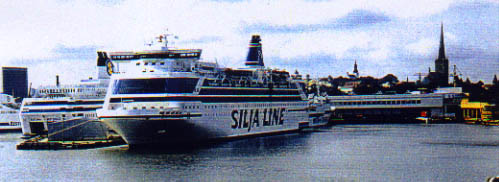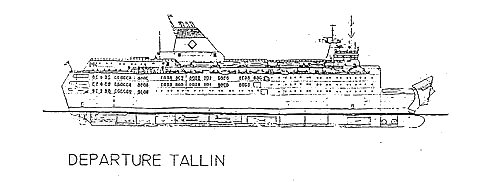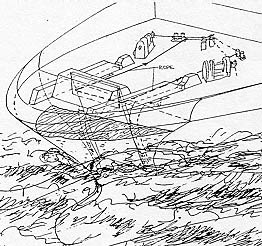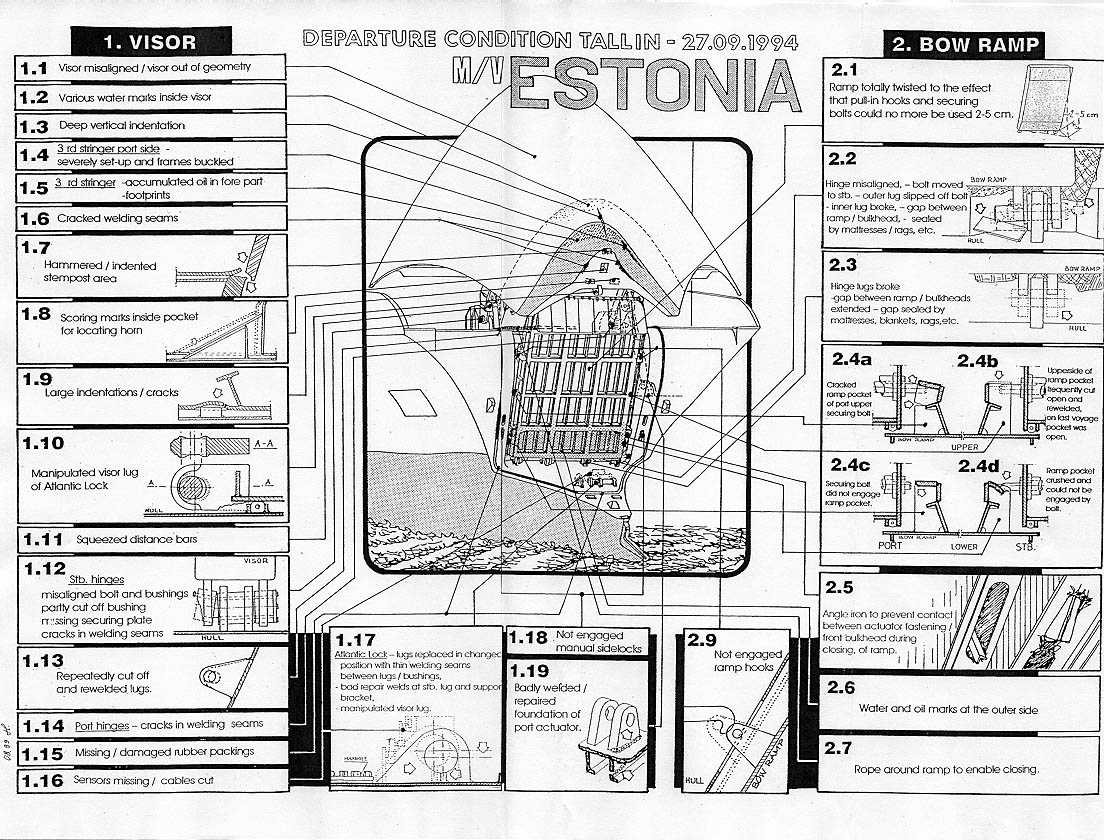ESTONIA pulled
back from her berth on 27 September 1994 between 19.15 and 19.30 hours.
According
to the JAIC the vessel departed at 19.15 hours which is said to be a compromise
between the Swedish/Finnish and the Estonian Commis-sion members. While the
Estonians insisted on 19.00 hours at the beginning (because the departure
time has effect on the speed), the Swedes and the Finns referred to the statement
of Bengt Nilsson - see Enclosure 20.238 - who had testified as follows:
»The vessel left the berth when they entered the restaurant, thus it must have been 19.30 hours or later, because the restaurant only opens at 19.30 hours.«
Andi Meister has
written in his book "The Unfinished Logbook", chapter 7, page 118,
that the time 19.15 hours for ESTONIA's departure could be found in the logbook
of the harbour master of Tallinn.
Upon departure
the vessel's trim was said to have been 0.5 m by stern and she had a list
of 1° to starboard, although the port heeling tank was full and the starboard
heeling tank was said to have been empty and in spite of the fact that gale
force winds had been forecasted from SW-ly direction, i.e. from port side,
thus increasing the starboard heel without any possibility to counteract.
When interviewed in 7/1996 motorman Elmar Siegel stated in this respect:
Q: "Did "Estonia"
leave Tallinn with some list?"
A: "Yes, a list to starboard. Leiger (chief engineer) had phoned the
engine room and asked whether it was possible to correct it. It was a mistake
made during loading. The tank at the side, which would have to be filled to
correct the list, was already full and the tank at the other side was already
empty. Therefore we had no possibility to correct the list. It was 1°-2° and
due to the waves up to 3°-4°."
The full
wording of the interview is attached as Enclosure
13.192.
According to the
crew member - car deck worker Valdur Matt - the bow ramp and visor were properly
closed and secured. He was probably the one who moved the turnable forward
parts of the bow-ramp rails into backward position and who secured both parts
by putting the pins into the respective holes before the bow ramp was lifted
up.
Also the passenger
Mikael Öun and others have stated that the visor was definitely closed or,
at least, looked closed from the open 8th deck when the ESTONIA pulled back
from her berth. Thereafter the passengers left the open deck because it was
windy and uncomfortable.
Since 17.00
hours on the same day the ferry SILJA FESTIVAL had been berthed opposite the
ESTONIA as pictured below.

In the cafeteria of SILJA FESTIVAL on the 4th deck a Finnish Doctor was having coffee with his son and thereby observed the unberthing manoeuvre of the ESTONIA. Her report - submitted to the Finnish part of JAIC on 10.01.95 and received by this 'Group of Experts' only in December 1998 - reads as follows:
»On Tuesday, 27 September 1994, at 13.00 hours, I boarded the SILJA FESTIVAL in Helsinki for a 24-hour cruise. I was accompanied by my son and we had a cabin together. The ferry arrived at Tallinn at 17.00 hours the same day for a 4-hour stay. Most of the passengers went ashore, but I stayed on board with my son and we were walking around the vessel. At about 19.00 hours I was together with my son in the cafeteria on the 4th deck having coffee. I saw through the window that a vessel with the name ESTONIA was leaving the harbour at a distance of about 20-25 m away from us. I knew the vessel from previous times..... The weather was overcast and it was blowing moderately ....... The day was just at dusk. I saw the vessel moving backwards from her berth and saw that her bow visor was open. It seemed to me that it was not fully open, but only half ....... I watched the ESTONIA for some minutes whereafter her foreship disappeared from my view. I did not see whether the vessel's so-called inner door was closed. While the vessel resumed her voyage I saw that both stern ramps were closed. I followed ESTONIA's departing for about 5 minutes whereafter the vessel disappeared into the darkness.
I mentioned to my son that the bow visor stood open and told him that for the same reason a Belgian vessel had sunk some time ago. I was informed by crew members of our vessel on the next morning at about 10.00 hours that the ESTONIA had sunk.«
The complete statement is attached as Enclosure 19.236.

The above drawing
shows ESTONIA with half open visor. This means that the crew apparently at
first closed the visor while the vessel proceeded backwards from the berth
and, subsequently, when she had turned inside the breakwater opened it again
to a certain extent, possibly half, and passed the breakwater in that condition.
The explanation
for this somewhat unusual behaviour was most probably the impossibility for
the crew to close the bow ramp completely, i.e. the ramp was closed by the
actuators to about 4-5 cm, whereafter normally the two ramp hooks would engage
the mating lugs at the upper part of the ramp and pull the ramp tight against
the rubber packings, whereafter the securing bolts would move one after the
other into mating pockets at the ramp; This was, however, no more possible
due to the severe twisting/misalignment of the ramp. This is subsequently
explained in detail in Subchapter 29.2, viz.:
(a) the port upper pocket was intact and only slightly bent towards the centre-line of the ramp with metal at both sides of the pocket slightly ripped which was probably caused by the bending; the bolt was fully extended and about 100 mm below the pocket;
(b) the port lower pocket was found to be intact with the bolt only partly extended and about 100 mm below the pocket;
(c) The starboard upper pocket was noted to be without cover plate which had been burnt off by the crew in the morning of 27 September 1994 after arrival when it turned out to be impossible to open the bolt; the bolt was fully extended; there was apparently no misalignment between bolt and pocket;
(d) the starboard lower pocket was crushed together to the effect that the bolt - noted to be fully extended - could never have entered the pocket.
Consequently it has
not been possible for the crew to secure the bow ramp at all by its four securing
bolts. The same refers to the port ramp hook which could not engage its mating
lug at the ramp, due to the misalignment of the port ramp side as it was demonstrated
already by the distance of ca. 100 mm between the mating pockets and bolts.
The obvious fact that the port ramp hook had never engaged its mating lug
is further confirmed by the intact hook and the intact, unbroken lug. Both
hook and lug are visible among other things on the diver video B40a. - See
also Subchapter 34.6.
The starboard
ramp hook, however, is nowhere visible and the location where it should be,
is empty. It has thus to be assumed that also this hook had not engaged its
mating lug at the ramp, which means that the ramp had just been closed by
the actuators - as stated before - to an remaining opening of 4-5 cm.
Due to several
mooring ropes and two wires found in way of the ramp and respective indications
on the ramp - see Chapter 29.2 - it has to be assumed that the crew tried
to close the ramp completely by means of mooring ropes and/or wires probably
pulled tight by means of the mooring winches on the forecastle deck.

Subsequently the visor was closed and locked - see Subchapter 29.2 and Chapter 30 - while the ferry proceeded already outside the breakwater towards the VTS between the Island Nayssaar and the mainland on her last, fatal voyage in a condition which shall again be summarised as follows:
- Severely damaged and misaligned visor, which at sea quickly filled up with water to the outside level, which was also insufficiently locked and secured, and the hinges of which were considerably pre-damaged and weakened, in particular the starboard hinge.
- Severely damaged and misaligned bow ramp, which was not locked at all but most likely held by one or more mooring rope(s)/wires, which was open to the water-filled visor, with the port hinges being broken and the ramp detached from the vessel at this side.
- The car deck loaded with only partly or not all secured trucks/trailers and other vehicles.
- The port heeling tank full while the starboard one was allegedly empty, a condition depriving the vessel's command subsequently of being able to counteract when the vessel's starboard heel increased due to the forecasted wind pressure on the port side.
- One or more ballast water tanks and/or void spaces being holed/leaking and consequently open to sea. In short, the ferry ESTONIA was in many respects unseaworthy when she departed from her home port for the last time as it is also demonstrated by the images below.
(click for full page image)
![]()
